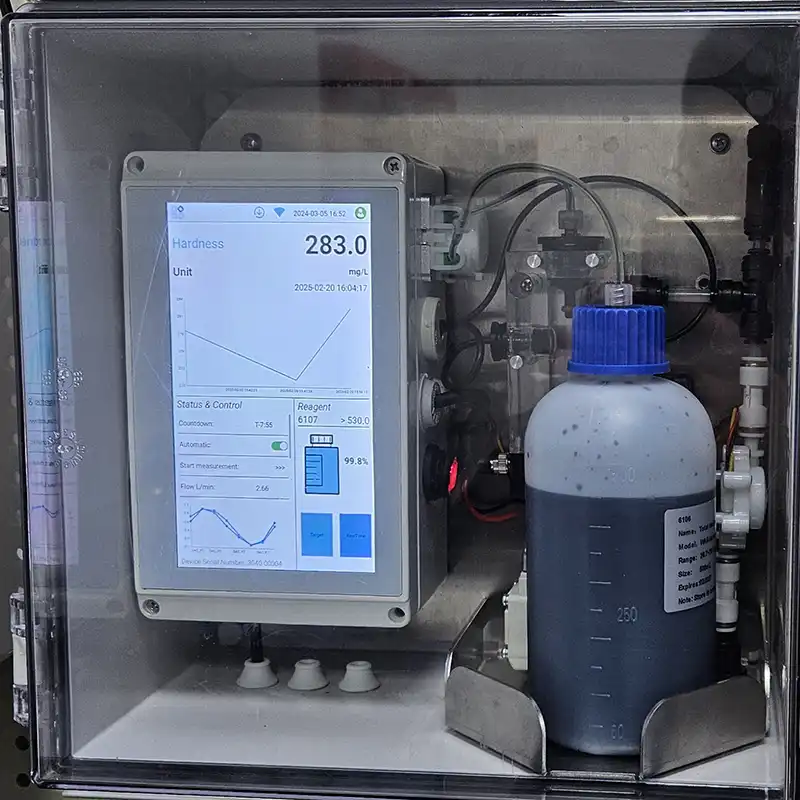Water quality sensors and hardness analyzers typically require specific chemical reagents to complete reactions and detect water hardness. Hardness analysis primarily targets calcium ions (Ca²⁺) and magnesium ions (Mg²⁺) in water. Below are the commonly used reagents and their functions:
1. Common Reagents for Hardness Analysis
1.1 EDTA (Ethylenediaminetetraacetic Acid)
- Function: EDTA is a chelating agent that forms stable complexes with calcium and magnesium ions.
- Usage: In titration methods, EDTA solution is used as the titrant, and the endpoint is determined by a color change (usually with an indicator).
- Indicator: Often used with Eriochrome Black T or Calmagite (calcium-magnesium indicator).
1.2 Buffer Solution
- Function: Maintains the pH of the reaction system to ensure the reaction between EDTA and calcium/magnesium ions proceeds smoothly.
- Common Buffer Solutions:
- Ammonia-Ammonium Chloride Buffer Solution (pH ≈ 10): Used for EDTA titration.
- Sodium Hydroxide Solution: Used to adjust pH.
1.3 Indicator
- Eriochrome Black T:
- Forms a red complex with calcium and magnesium ions at pH 10.
- The solution changes from red to blue when EDTA fully reacts with calcium and magnesium ions.
- Calmagite:
- Similar to Eriochrome Black T but more stable, suitable for a wider range of water conditions.
1.4 Standard Calcium Solution
- Function: Used for instrument calibration or to verify reagent effectiveness.
- Composition: A solution of known calcium ion concentration (e.g., calcium carbonate dissolved in hydrochloric acid).
2. Working Principle of Hardness Analysis
2.1 Titration Method
- Take a certain amount of water sample and add a buffer solution to adjust the pH to 10.
- Add an indicator (e.g., Eriochrome Black T), turning the solution red.
- Titrate with EDTA solution until the solution changes from red to blue.
- Calculate the total hardness based on the amount of EDTA consumed.
2.2 Colorimetric Method
- Mix the water sample with reagents to initiate a color reaction.
- Use a photometer to measure the absorbance of the solution and calculate hardness based on a standard curve.
2.3 Electrode Method
- Use a calcium ion-selective electrode to directly measure calcium ion concentration in water.
- Calculate magnesium ion concentration by subtracting calcium ion concentration from total hardness.
3. Considerations for Reagent Selection
- Reagent Purity: Use high-purity reagents to avoid interference from impurities.
- Storage Conditions:
- EDTA solution should be stored away from light.
- Indicators and buffer solutions should be sealed to prevent degradation.
- Safety: Some reagents (e.g., ammonia, hydrochloric acid) are corrosive or irritating. Wear protective equipment during operation.
Summary
Common reagents used in water quality sensors and hardness analyzers include EDTA, buffer solutions, indicators (e.g., Eriochrome Black T), and standard calcium solutions. These reagents accurately measure calcium and magnesium ion concentrations in water through titration, colorimetry, or electrode methods, thereby determining water hardness.

